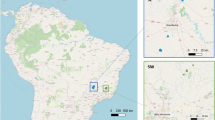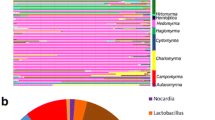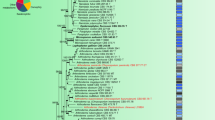Abstract
This study identifies the bacteria associated with ectoparasitic chewing lice that live in the fur of pocket gophers. Samples of chewing lice were collected from pocket gopher hosts in Florida, Missouri, New Mexico, and Costa Rica. We used a molecular sampling method whereby total community DNA was extracted from samples of chewing lice, and PCR was used to selectively amplify small-subunit rRNA genes from bacteria. This culture-independent method yielded ca. 35 distinct lineages representing eight widely divergent groups within the domain Bacteria. Phylogenetic analysis of two lineages (Acinetobacter and Staphylococcus) provides evidence that multiple species of each group are found in chewing lice. Phylogenetic analysis also demonstrated that diversification within chewing lice may be evident in both Acinetobacter and Staphylococcus. Some clones amplified from chewing louse hosts appeared to be distinct from known species of Acinetobacter and Staphylococcus. This diversification may be the result of the extreme isolation of populations of both chewing lice and their pocket gopher hosts.
Similar content being viewed by others
References
Baumann P, Moran NA (1997) Non-cultivable microorganisms from symbiotic associations of insects and other hosts. Antonie von Leeuwenhoek 72:39–48
Cunningham CW, Zhu H, Hillis DM (1998) Best-fit maximum likelihood models for phylogenetic inference: empirical tests with known phylogenies. Evolution 52:978–987
Demastes JW, Hafner MS (1993) Cospeciation of pocket gophers and their chewing lice. J Mamm 74:521–530
Douglas AE (1989) Mycetocyte symbiosis in insects. Biol Rev Cambridge Phil Soc 64:409–434
Hafner MS, Nadler SA (1988) Phylogenetic trees support the coevolution of parasites and their hosts. Nature 332:258–259
Hafner MS, Demastes JW, Spradling TA, Reed DL In press. Cophylogeny between pocket gophers and chewing lice. In: RDM Page (ed), Tangled Trees: Phylogenies, Cospeciation, and Coevolution. University of Chicago Press
Hafner MS, Sudman PD, Villabianca FX, Spradling TA, Demastes JW, Nadler SA (1994) Disparate rates of molecular evolution in cospeciating hosts and parasites. Science 265:1087–1090
Hugenholtz P, Goebel BM, Pace NR (1998) Impact of culture-independent studies on the emerging phylogenetic view of bacterial diversity. J Bacteriol 180:4765–4774
Ishikawa H (1989) Biochemical and molecular aspects of endosymbiosis in insects. Int Rev Cytol 116:1–45
Jeyaprakash A, Hoy MA (2000) Long PCR improves Wolbachia DNA amplification: wsp sequences found in 76% of sixty-three arthropod species. Insect Mol Biol 9:393–405
Komatsoulis GA, Waterman MS (1997) A new computational method for detection of chimeric 16S rRNA artifacts generated by PCR amplification from mixed bacterial populations. Appl Environ Microbiol 63:2338–2346
Lambert LH, Cox T, Mitchell K, Rossello-Mora RA, Del Cueto C, Dodge DE, Orkland P, Cano RJ (1998) Staphylococcus succinus sp. nov., isolated from Dominican amber. Int J Syst Bacteriol 48:511–518
Moran NA, Telang A (1998) Bacteriocyte-associated symbiosis of insects. Bioscience 48:295–304
Nardon P, Grenier AM (1989) CRC Handbook on endocytobiosis in Coleoptera: Biological, biochemical, and genetic aspects. In: W Schwemmler, G Gassner (eds) Insect Endocytobiosis: Morphology, Physiology, Genetics, and Evolution. Boca Raton, FL pp 175–216
Pace NR (1997) A molecular view of microbial diversity and the biosphere. Science 276:734–740
Page RDM (1990) Temporal congruence and cladistic analysis of biogeography and cospeciation. Syst Zool 39:205–226
Patton JL, Smith MF, Price RD, Hellenthal RA (1984) Genetics of hybridization between the pocket gophers Thomomys bottae and Thomomys townsendii in northeastern California. Great Basin Naturalist 44:431–440
Posada D, Crandall KA (1998) Modeltest: testing the model of DNA substitution. Bioinformatics 14:817–818
Rainey FA, Lang E, Stackebrandt E (1994) The phylogenetic structure of the genus Acinetobacter. FEMS Microbiol Lett 124:349–354
Ries E (1931) Die symbiose der Läuse und Federlinge. Zeitschr Morph Ökol Tiere 20:233–367
Robison-Cox JF, Bateson MM, Ward DM (1995) Evaluation of nearest-neighbor methods for detection of chimeric small-subunit rRNA sequences. Appl Environ Microbiol 61:1240–1245
Saffo MB (1992) Invertebrates in endosymbiotic associations. Am Zoologist 32:57–565
Saxena AK, Agarwal GP (1985) Mycetocytes in Aegypoecus perspicuus (Phthiraptera). Curr Sei 54(15):763–764
Suzuki MT, Giovannoni SJ (1996) Bias caused by template annealing in the amplification of mixtures of 16S rRNA genes by PCR. Appl Environ Microbiol 62:625–630
Swofford DL (2001) PAUP*. Phylogenetic Analysis Using Parsimony (and Other Methods). Version 4. Sinauer Associates, Sunderland, MA
Thompson JD, Gibson TJ, Plewniak F, Jeanmougin F, Higgins DG (1997) The ClustalX windows interface: flexible strategies for multiple sequence alignment aided by quality analysis tools. Nucleic Acids Res 24:4876–4882
Timm RM (1983) Farenholz’s Rule and resource tracking: A study of host-parasite coevolution. In: M Nitecki (ed) Coevolution. University of Chicago Press, Chicago, pp 225–266
Wang GC-Y, Wang Y (1997) Frequency of formation of chimeric molecules as a consequence of PCR coamplification of 16S rRNA genes from mixed bacterial genomes. Appl Environ Microbiol 63:4645–4650
Ward DM, Ferris MJ, Nold SC, Bateson MM (1998) Natural view of microbial biodiversity within hot spring cyanobacterial mat communities. Microbial Molec Biol Rev 62:1–18
Woese CR (1994) There must be prokaryote somwehere: microbiology’s search for itself. Microbiol Rev 58:1–9
Author information
Authors and Affiliations
Corresponding author
Additional information
Online publication: 20 May 2002
Rights and permissions
About this article
Cite this article
Reed, D.L., Hafner, M.S. Phylogenetic analysis of bacterial communities associated with ectoparasitic chewing lice of pocket gophers: A culture-independent approach. Microb Ecol 44, 78–93 (2002). https://doi.org/10.1007/s00248-002-0009-4
Received:
Accepted:
Issue Date:
DOI: https://doi.org/10.1007/s00248-002-0009-4




